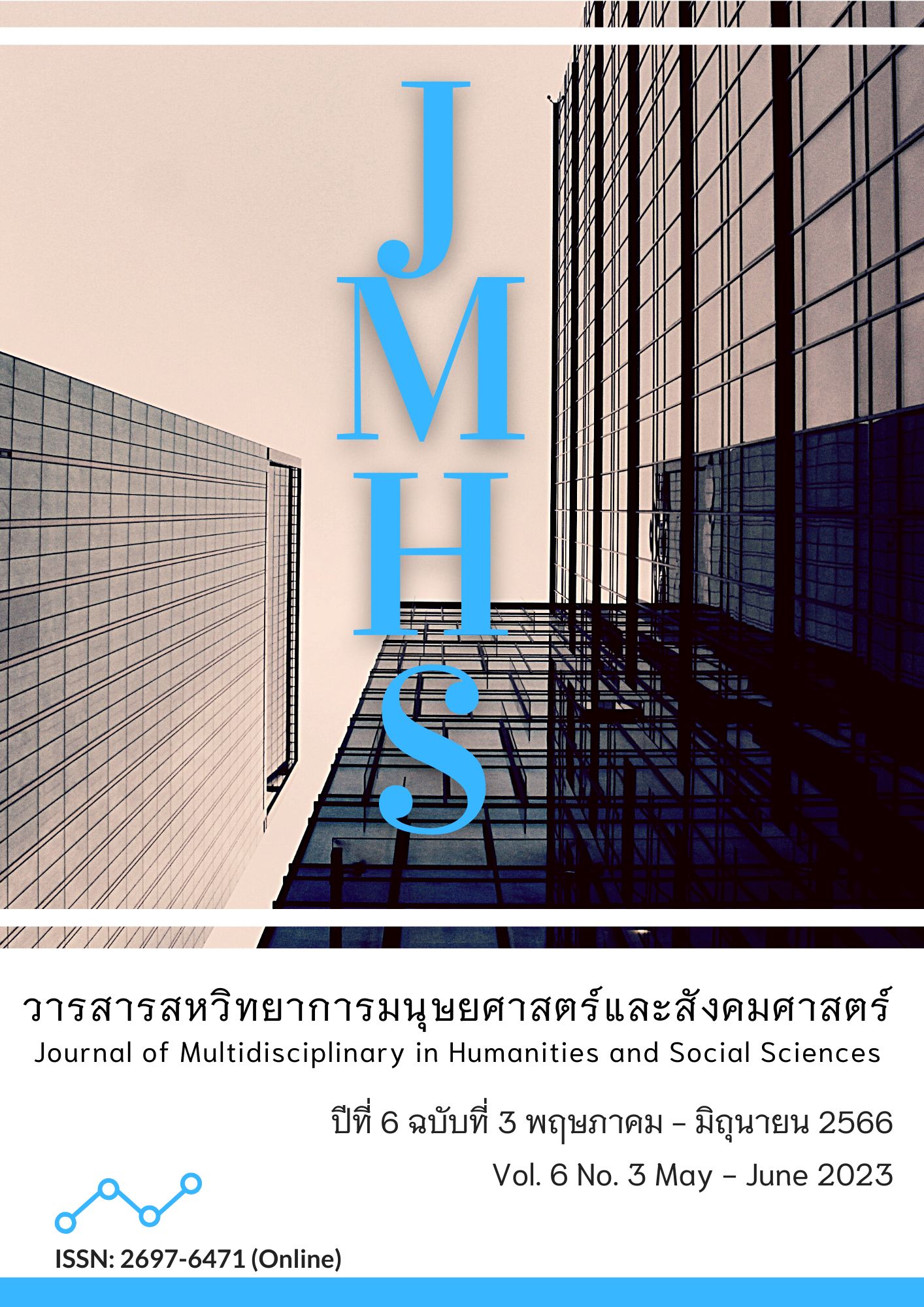Effects of Using Historical Method on Using Primary Sources as Evidence in Constructing Knowledge About the Past and the Attitude Towards Local History in Ratchaburi Studies of Upper Secondary Students
Main Article Content
Abstract
This study aimed to 1) examine the ability to use primary sources as evidence in constructing knowledge about the past of upper secondary students using the historical method and 2) study the attitude of upper secondary students using the historical method towards local history in Ratchaburi studies. The participants in this study were 40 students from Matthayomsuksa 4/5 studying in the second semester during the academic year 2021 at Phothawatthanasenee school, Photharam district, Ratchaburi, under the Secondary Educational Service Area Office Ratchaburi. The research instruments employed to collect data were: 1) lesson plans; 2) a student behavior assessment observation form; and 3) a Likert scale questionnaire on the attitude of students towards local history in Ratchaburi studies. The collected data was analyzed by mean and standard deviation. The findings were as follows: 1. The development of the ability to use primary sources as evidence in constructing knowledge about the past of upper secondary students after using the historical method reached a higher level; and 2. The attitude of upper secondary students towards local history in Ratchaburi studies after using the historical method reached a high level.
Article Details

This work is licensed under a Creative Commons Attribution-NonCommercial-NoDerivatives 4.0 International License.
Views and opinions appearing in the Journal it is the responsibility of the author of the article, and does not constitute the view and responsibility of the editorial team.
References
กระทรวงศึกษาธิการ. (2551). หลักสูตรแกนกลางการศึกษาขั้นพื้นฐาน พ.ศ. 2551. กรุงเทพฯ: ชุมนุมสหกรณ์การเกษตรแห่งประเทศไทย.
กระทรวงศึกษาธิการ. (2551). พระราชบัญญัติการศึกษาแห่งชาติ พ.ศ. 2551. กรุงเทพฯ: องค์การรับส่งสินค้าและพัสดุภัณฑ์ (ร.ส.พ.).
ระวัฒน์ วงศ์สวัสดิวัฒน์. (2547). ทัศนคติ ความเชื่อ และพฤติกรรมความเชื่อ: การวัดการพยากรณ์และการเปลี่ยนแปลง. กรุงเทพฯ: มหาวิทยาลัยอัสสัมชัญ.
เฉลิม นิติเขตต์ปรีขา. (2545). เทคนิควิธีการสอนประวัติศาสตร์. กรุงเทพฯ: ไทยวัฒนาพานิช.
เฉลิม นิติเขตต์ปรีขา. (2559). เทคนิควิธีการสอนประวัติศาสตร์. กรุงเทพฯ: จุฬาลงกรณ์มหาวิทยาลัย.
ชัยรัตน์ โตศิลา. (2555). พัฒนากระบวนการเรียนการสอนโดยใช้วิธีการทางประวัติศาสตร์มาบูรณาการร่วมกับ วิธีการศึกษาหลักฐานทางประวัติศาสตร์อย่างมีระบบโดยเรียงลำดับการพิจารณาเป็น 1-2 และ 3 Drake และ Brown (2003) เพื่อส่งเสริมทักษะการคิดทางประวัติศาสตร์ของนักเรียนชั้นมัธยมศึกษาปีที่ 2.(วิทยานิพนธ์ปริญญาดุษฎีบัณฑิต). จุฬาลงกรณ์มหาวิทยาลัย.
ทีฆกุล คำงาม. (2560). ผลของการจัดการเรียนรู้ประวัติศาสตร์ท้องถิ่นโดยใช้กระบวนการเรียนการสอน DACIR ที่มีต่อการเรียนรู้มโนทัศน์ทางประวัติศาสตร์ของนักเรียนประถมศึกษาที่ 5.(วิทยานิพนธ์ปริญญาปรัชญามหาบัณฑิต). มหาวิทยาลัยศิลปากร.
ธีรวุฒิ เอกะกุล. (2550). การวัดเจตคติ. (พิมพ์ครั้งที่ 2). อุบลราชธานี: วิทยาออฟเซทการพิมพ์.
นิธิ เอียวศรีวงศ์. (2525). หลักฐานประวัติศาสตร์ในประเทศไทย. กรุงเทพฯ: บรรณกิจ.
นิธิ เอียวศรีวงศ์. (2550). ประวัติศาสตร์นิพนธ์ตะวันตก. กรุงเทพฯ: มูลนิธิโครงการตำราสังคมศาสตร์และมนุษย์ศาสตร์.
ประกอบ มณีโรจน์. (2554). หลักสูตรสถานศึกษา: หลักสูตรท้องถิ่น : สาระการเรียนรู้ท้องถิ่น “อะไร ทำไม อย่างไร”. สงขลา: สำนักงานเขตพื้นที่การศึกษาประถมศึกษาสงขลา เขต 2.
พรเพ็ญ ฮั่นตระกูล. (2556). เทคนิคการสอนและการใช้นวัตกรรมการสอนประวัติศาสตร์ในประวัติศาสตร์ ศาสนา วัฒนธรรม และการศึกษา: รวมบทความไทยศึกษาเพื่อระลึกถึงศาสตราจารย์อิฌิอิ โยเนะโอะ. กรุงเทพฯ: ด่านสุทธาการพิมพ์.
ลาวัลย์ วิทยาวุฒิกุล และคณะ. (2543). คู่มือการเรียนการสอนประวัติศาสตร์ไทย. กรุงเทพฯ: ไทยวัฒนาพานิช.
วินัย พงศ์ศรีเพียร. (2543). คู่มือจัดกิจกรรมการเรียนการสอนประวัติศาสตร์ ประวัติศาสตร์ไทยจะเรียนกันอย่างไร. กรุงเทพฯ: การศาสนา กรมศาสนา.
วีณา เอี่ยมประไพ. (2549). หลักฐานทางประวัติศาสตร์. กรุงเทพฯ: โอ เอส พริ้นติ้งเฮาส์.
ศศิพัชร จำปา. (2558). การพัฒนารูปแบบการจัดการเรียนรู้ประวัติศาสตร์ท้องถิ่นโดยใช้แหล่งเรียนรู้ทางประวัติศาสตร์ เพื่อส่งเสริมกระบวนการคิดทางประวัติศาสตร์.(วิทยานิพนธ์ปริญญาปรัชญาดุษฎีบัณฑิต). มหาวิทยาลัยศิลปากร.
สิริวรรณ ศรีพหล. (2539). เอกสารการสอนชุดวิชาการสอนสังคมศึกษา. นนทบุรี: มหาวิทยาลัยสุโขทัยธรรมาธิราช.
สิริวรรณ ศรีพหล. (2554). การจัดการเรียนรู้การสอนกลุ่มสาระการเรียนรู้สังคมศึกษา ศาสนา และวัฒนธรรม. นนทบุรี: มหาวิทยาลัยสุโขทัยธรรมาธิราช.
หวน พินธุพันธ์. (2546). การเรียนโดยเน้นผู้เรียนเป็นสำคัญ : ปฏิรูปการศึกษาที่สำคัญที่สุด. กรุงเทพฯ: ไทยวัฒนาพานิช.
Bloom, B.S. (1956). Taxonomy of Educational Objectives, Handbook I: The Cognitive Domain. New York: David McKay.
David, R., & Cheruiyot, R.O. (2016). An Assessment of the Attitudes of Students towards History and Government in Selected Secondary Schools in Bomet County in Kenya. Journal of Education and Practice, 7(19), 90-94.
Seixas, P., & Morton, T., (2013). The Big six: Historical Thinking Concepts. Toronto: Nelson Education.


